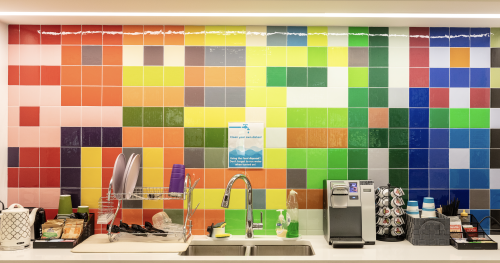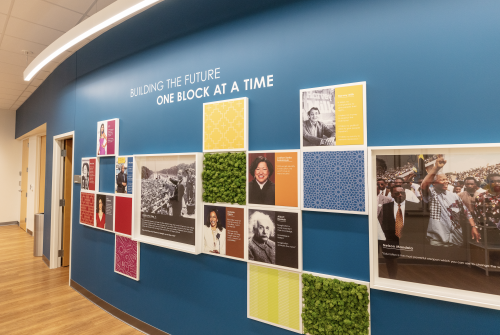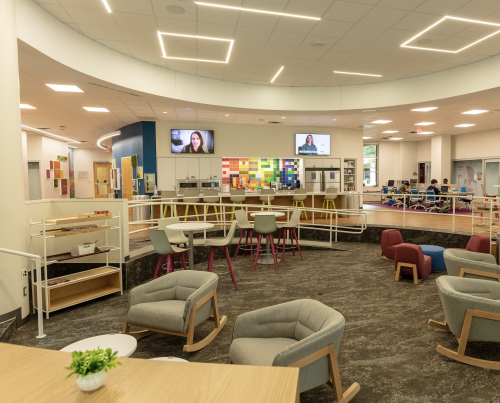
Brian Dickson Jr. stands in front of "The World Is Ours” at TCU’s new Intercultural Center. He and fellow mural artist Kristian Gaytan painted the art at the center's entrance. “When you’re in this space,” he says, “you don’t have to code switch.” Photo by Vishal Malhotra
The World is Ours
TCU’s student-designed Intercultural Center helps promote belonging.
Housed on the first level of the Brown-Lupton University Union, TCU’s 1-year-old Intercultural Center has become a safe haven and community-building space for people of all cultures, identities and backgrounds.
The design may be new, but TCU students have been envisioning an intercultural center for decades. THE CENTER PROVIDES A SPACE WHERE “STUDENTS ARE WELCOME TO BE THEIR AUTHENTIC SELVES WHILE ALSO APPRECIATING AND VALUING OTHERS’ ABILITY TO DO THE SAME.”
Timeka Gordon
“Just to have a dedicated space on campus for students of color, LGBTQ+ students and international students — it says a lot because it’s a safe space for cultures that are not always represented,” said Shelby Johnson ’20 (MEd ’22).
Trung Nguyen ’21 EdD, a former assistant vice chancellor for student identity and success, said that when students became vocal in the last decade about building a more inclusive culture at TCU, administrators looked at how they could improve the college experience for everyone.
Student requests in 2015 led to construction of pillars in Worth Hills for the National Pan-Hellenic Council, which oversees Black fraternities and sororities. In 2016, other students issued a list of demands to administrators that included online sensitivity training for all campus constituents; a diversity, inclusion and belonging training module is now required for all faculty and staff.
Also in 2016, Nguyen said, social media activism further emphasized to TCU leaders the students’ desire to have a more inclusive campus culture and infrastructure.
In 2020, TCU held campus listening sessions to give the floor to students from historically marginalized and underserved groups.
“There was a lot of social unrest amongst the student body,” Johnson said, “and so we really wanted to do something about it.”
Johnson founded a group called the Coalition for University Justice and Equity. The group’s wish list included a new building to house an intercultural center.
Chancellor Victor J. Boschini, Jr. embraced the request and tasked a vision committee with finding a place for it.

The kitchen area includes a colorful backsplash mosaic representing the colors of international flags. John Singleton, former director of international services, proposed the idea. Photo by Vishal Malhotra
Costs and available space prohibited construction of a building. The vision committee, which consisted of 14 students and staff members, looked for a suitable compromise in a large, central spot on campus.
Johnson said that at first she hesitated to accept the decision to host the space within the university union building. “I was very much like, ‘This doesn’t satisfy the demand.’ ”
The first look at the new space changed her mind.
“I was pleased with what they did,” Johnson said. “I was happy because they were able to bring some of the demands to light through that space, and the way that they transformed that area was just beautiful.”
Nguyen said the collaborative effort was a major success. “I was really proud that I was able to be involved in a process where TCU and our students worked together to create a space that the students loved but also TCU can highlight.”
Design Details
The Intercultural Center “is committed to cultivating a campus community that celebrates underrepresented students’ identities, cultures and experiences,” according to a purpose statement written by Timeka Gordon ’21 EdD, director of the center, the Community Scholars program and Student Identity & Engagement. The center provides a space where “students are welcome to be their authentic selves while also appreciating and valuing others’ ability to do the same.”
The center houses five formal university offices: Community Scholars Program, Gender Resource Office, International Services, Student Government Association and Student Identity & Engagement.

A wall in TCU’s Intercultural Center features inspirational quotes. The space’s design includes more variable colors than TCU’s traditional purple and white. Photo by Vishal Malhotra
Each aspect of the Intercultural Center, from the aesthetics to the operational components, was designed with student input.
“The spirit of the center is to make you feel at home, loved on and being in community,” Gordon said.
A kitchen features refrigerators, TVs, warming ovens, a large countertop and a backsplash mosaic representing the colors of international flags.
A pit area, referred to as the living room, includes movable furniture to encourage comfort and connection.
A multimedia conference room has a green screen that allows students to host meetings and create social media content.
“We got it to feel as homey as we could,” said vision committee member Mikea Jackson ’22. “I really wanted to advocate for student artists to touch the space, and obviously, their work speaks for itself.”
After construction, the vision committee noticed a huge blank wall at the center’s entrance. Jackson pushed for fellow committee member Kristian Gaytan, a senior political science and comparative race and ethnic studies major, and Brian Dickson Jr. ’22 to create artwork for the wall. The two were good friends from Fort Worth’s Young Men’s Leadership Academy, which both attended prior to TCU.
Together, Gaytan and Dickson painted the mural “The World Is Ours,” showcasing a Black woman and Mexican man; the Fort Worth skyline; a collection of colorful hands, flowers and butterflies; and the Earth.
This is the most colorful space on campus,” Gordon said. “It makes you smile and it makes your eyes get wide. All of that was intentional. Culture is about liveliness and fun and that’s what this space brings.”
A Model for Collaboration
The Intercultural Center now serves as a model to other institutions that desire similar spaces, Nguyen said. “It’s not just a representation of what TCU and students can do when working together. I think it’s a role model for higher ed across the country to show that when both sides are willing to listen to each other and work together, we can do some great things.”
During the 2021-22 academic year, the Intercultural Center had 331 reservations and 8,074 attendees.
Hosting cultural celebrations such as Día de los Muertos and Diwali, educational workshops on cultural competency, a voter registration drive and World Cup watch parties, the center has been versatile.
Jackson hopes the strong utilization of the Intercultural Center continues to keep the conversation alive regarding more space on campus.

CannonDesign partnered with TCU on the Intercultural Center,
where students can study, lounge and engage. Photo by Vishal Malhotra
“I don’t think that we should stop here,” she said. “I do think there needs to be a larger space, but I do think it’s a start.”
Organizations can expect privacy in the conference room but not in the living room area. This policy encourages interaction. “The living room is reservable, but it’s an open space, meaning that if someone is sitting in there, you can’t boot them out,” Gordon said. “They’ll either naturally get up because they realize there’s a program or event happening or they’ll take a seat and engage.”
Gordon said she is interested in reconnecting with past Horned Frogs and engaging with community members who want to be part of TCU and hopes they will feel at home in the Intercultural Center.
“There are decades of students and alumni who have been challenged in their experience at TCU and had been wanting a space like this but didn’t have it while they were here,” Nguyen said. “I think we owe it to them to make sure that they feel as equally welcomed into that space as do our current students.”
One idea is to offer the center up as a tailgating spot for TCU’s ethnic and LGBTQ+ alumni affinity associations.
“Could you imagine a better tailgating spot?” Nguyen said. “Wouldn’t it be great for us to be able to partner with those alumni associations to say, ‘Hey, you want a tailgating space [away from] the heat when everyone else is out there and it’s 110 degrees?’ ”
Johnson said she’s a fan of the idea. “I feel like the more opportunities that TCU gives us as alums to come back and show support for current students, to show our Horned Frog pride, the happier I am to show up and attend.”
Jackson said the student sacrifice to establish the Intercultural Center shouldn’t be forgotten. Students worked hard while also juggling schoolwork, extracurricular activities, jobs and more.
Gaytan said he is pleased with how the center has taken shape and the mural’s role in helping create a place of inclusion. “We feel it’s had a tremendous impact on campus, and when people walk through it, they feel seen,” he said. “I feel like for us, the mission was accomplished.”
Dickson said the center is a place of refuge. “When you walk in the space, you don’t have to code switch,” he said. “You don’t have to prepare yourself to be somebody who you’re really not; you can just be yourself and just breathe because a lot of times walking on this campus, I’m very self-conscious. I’m like, ‘Who’s watching me?’ With the Intercultural Center, freedom is what I feel.”

Your comments are welcome
Comments
Related reading:
Features
Black Student Presidents Blaze Trails
Leslie Ekpe and Lau’Rent Honeycutt are first to hold their offices.
Features
Building Interfaith Bridges
By keeping the faith dialogue open and respectful, TCU prepares students for a religiously diverse world.